Shuttle SN27P2 SFF: AM2 gets the Tiny Treatment
by Jarred Walton on June 30, 2006 11:00 PM EST- Posted in
- Systems
Noise, Heat and Power
We mentioned already that the changes to our SFF test platform make it difficult to compare this new system with previous offerings. To provide something of an apples-to-apples comparison, we equipped an SN25P with an X2 4600+ (overclocked to 2.6 GHz to reach equivalent performance to the 5000+). Noise measurements were then taken at idle and at full load at a distance of 48", using both a 7900 GTX and an XFX 7600 GT XXX. Full load was achieved by running two instances of Folding@Home while looping 3DMark05. Idle measurements were taken with the system at the Windows desktop and no applications running. In order to measure CPU temperatures, we used the NVIDIA nTune 5.0 System Monitor; there may be differences between the motherboards and chipsets when reporting processor temperatures, but the important thing is that the systems run stable, and we can attest to the fact that none of the systems crashed during testing (except when we tried overclocking). Finally, system power draw was measured at the wall outlet using a Kill-A-Watt device.
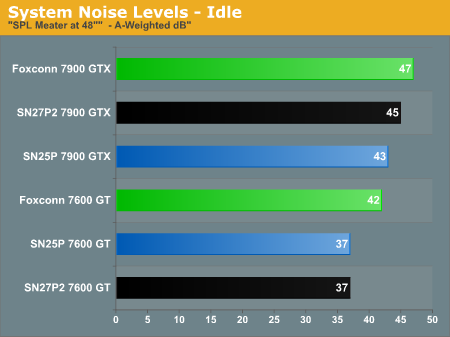
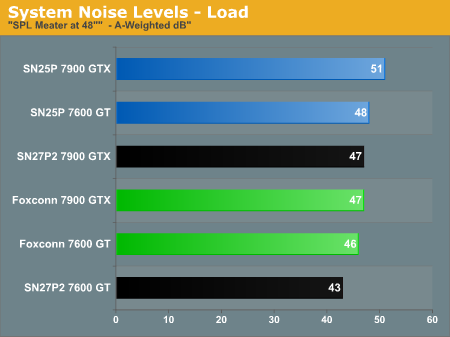
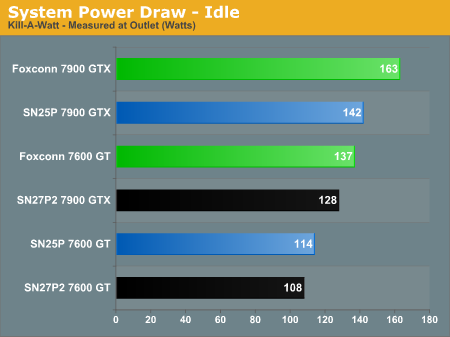
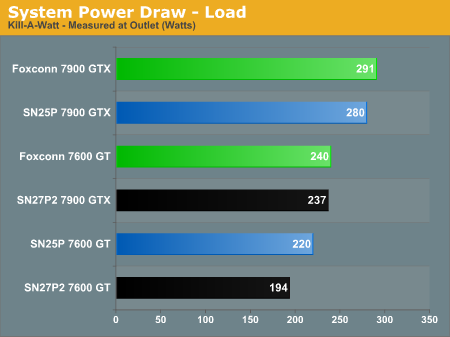
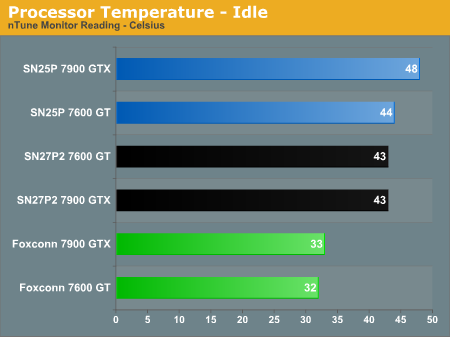
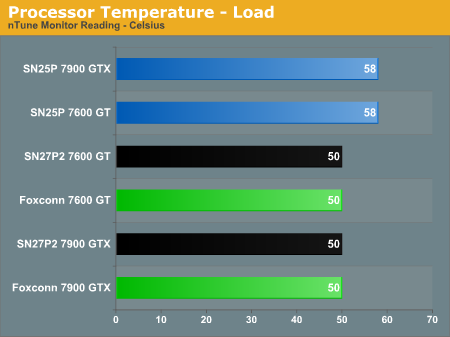
First, in terms of noise, the SN27P2 tends to run slightly quieter than the old SN25P. Looking at the power draw numbers, it also uses slightly less power, which probably accounts for the difference in noise levels that we're measuring. The difference in power draw is almost certainly caused by the switch from DDR to DDR2 memory -- 2.6V versus 2.0V in our test systems. Also note that the testing environment is slightly warmer than in previous SFF articles: 24°C versus 21°C. Testing during less hospitable times of day at room temperatures of 34°C did result in slightly higher noise levels at idle, but maximum noise level were generally consistent. The difference is that maximum noise levels were more easily achieved with a higher ambient temperature. It's definitely worth noting the relatively large difference in noise levels between the 7600 GT and 7900 GTX configurations. It doesn't matter as much in the ATX system, but in the SFF units the huge 7900 GTX card really adds a lot of noise at idle.
You can see that the noise and power testing hasn't changed radically from socket 939. When the system is idle, it is relatively quiet, and system power draw is within 15W. Once you place a full load on the processor -- especially if you put 100% load on both CPU cores -- the CPU fan speed and noise levels ramp up substantially, and the increased strain on the memory subsystem results in a 40W difference. Both SFF units still use less power than a full-size ATX motherboard, though likely that has as much to do with the 700 W OCZ power supply as it does with the motherboard size. In terms of CPU temperatures, it is important to note that both Shuttle systems are functioning with "smart" fan speed controls enabled, so the maximum CPU temperature is generally consistent while higher noise levels are generated under high CPU loads.
Provided you don't plan on running CPU intensive tasks 24/7, the typical noise levels are quieter than what most desktop systems provide. (Of course, you could also spend some effort to build a nearly-silent desktop PC if that's what you want.) If you pair the system up with a fanless GPU, it won't be silent, but it will also be far from annoyingly loud in most instances. Load up a game or perform some heavy video encoding -- or perhaps both at the same time -- and that assessment changes, of course.
We mentioned already that the changes to our SFF test platform make it difficult to compare this new system with previous offerings. To provide something of an apples-to-apples comparison, we equipped an SN25P with an X2 4600+ (overclocked to 2.6 GHz to reach equivalent performance to the 5000+). Noise measurements were then taken at idle and at full load at a distance of 48", using both a 7900 GTX and an XFX 7600 GT XXX. Full load was achieved by running two instances of Folding@Home while looping 3DMark05. Idle measurements were taken with the system at the Windows desktop and no applications running. In order to measure CPU temperatures, we used the NVIDIA nTune 5.0 System Monitor; there may be differences between the motherboards and chipsets when reporting processor temperatures, but the important thing is that the systems run stable, and we can attest to the fact that none of the systems crashed during testing (except when we tried overclocking). Finally, system power draw was measured at the wall outlet using a Kill-A-Watt device.






First, in terms of noise, the SN27P2 tends to run slightly quieter than the old SN25P. Looking at the power draw numbers, it also uses slightly less power, which probably accounts for the difference in noise levels that we're measuring. The difference in power draw is almost certainly caused by the switch from DDR to DDR2 memory -- 2.6V versus 2.0V in our test systems. Also note that the testing environment is slightly warmer than in previous SFF articles: 24°C versus 21°C. Testing during less hospitable times of day at room temperatures of 34°C did result in slightly higher noise levels at idle, but maximum noise level were generally consistent. The difference is that maximum noise levels were more easily achieved with a higher ambient temperature. It's definitely worth noting the relatively large difference in noise levels between the 7600 GT and 7900 GTX configurations. It doesn't matter as much in the ATX system, but in the SFF units the huge 7900 GTX card really adds a lot of noise at idle.
You can see that the noise and power testing hasn't changed radically from socket 939. When the system is idle, it is relatively quiet, and system power draw is within 15W. Once you place a full load on the processor -- especially if you put 100% load on both CPU cores -- the CPU fan speed and noise levels ramp up substantially, and the increased strain on the memory subsystem results in a 40W difference. Both SFF units still use less power than a full-size ATX motherboard, though likely that has as much to do with the 700 W OCZ power supply as it does with the motherboard size. In terms of CPU temperatures, it is important to note that both Shuttle systems are functioning with "smart" fan speed controls enabled, so the maximum CPU temperature is generally consistent while higher noise levels are generated under high CPU loads.
Provided you don't plan on running CPU intensive tasks 24/7, the typical noise levels are quieter than what most desktop systems provide. (Of course, you could also spend some effort to build a nearly-silent desktop PC if that's what you want.) If you pair the system up with a fanless GPU, it won't be silent, but it will also be far from annoyingly loud in most instances. Load up a game or perform some heavy video encoding -- or perhaps both at the same time -- and that assessment changes, of course.










17 Comments
View All Comments
SoSpartan - Tuesday, August 1, 2006 - link
Why do you state that the SN27P2 has a 400W power supply when your pictures clearly show a 350W power supply? Shuttle's website says 400W prominently, but their PDF spec sheet says 350W! What's the deal? The extra 50W could make the difference between running a nVidia 6800 vs 7900GTX or 7950GX2 stably!akp - Sunday, July 2, 2006 - link
Nice review in general, but I feel like there's one thing really missing. As you say on page 6 (Benchmark setup):The key feature for the SN27P2 of course is its size, but noise control is also likely to be a major consideration.
If you are simply planning on using the system as the core of an HTPC, our recommendation would be to grab one of the many fan-less GPUs that are coming to market, probably a 7600 (GT as an upgrade) or an X1600 Pro/XT would strike a decent balance between performance and power/heat requirements.
Given those factors, wouldn't it have made a lot of sense to include a fanless GPU in your benchmark setup? I really have to wonder how much of the power draw and noise was coming just from the graphics card in those tests.
JarredWalton - Sunday, July 2, 2006 - link
Actually, the majority of the noise under full load with the 7600GT comes from the CPU. However, the GPU is contributing a bit in that configuration. A fan-less GPU wasn't included because I don't have one at present. The idle noise with the 7600 GT used is almost entirely generated by the CPU/case cooling - maybe subtract 2 dB for the GPU at best.artifex - Saturday, July 1, 2006 - link
What was the temperature like when all bays were full of either hard drives or an active DVD burner? I'm wondering if it can really keep up in a situation like that. In my tower, my drives seem to get really hot without extra cooling. Please consider adding a test like this the next time you review SFFs.Also, e-SATA sounds cool, but that's strictly a drive interface. Wouldn't another firewire port have been more useful? Is e-SATA faster than FW400? If I use the firewire in the back for one external firewire drive, that means I'm left with a minifw in front for video cameras, etc. I'd really like more flexibility, there, so I'll be looking forward to your reviews of other AM2 SFFs for sure.
JarredWalton - Saturday, July 1, 2006 - link
SATA tops out at 300 MB per second these days (though in reality hard drives can't come near that number for sustained performance). FireWire 1394b tops out at 800 Mbps (one third as fast) and 1394a only hits 400 Mbps. That said, FireWire is a far more flexible interface, as there are many peripherals that use it. So far SATA is only for hard drives.As for installing three HDDs, I'd be very nervous if they were all hot drives. However, I have an SN25P with two HDDs that has been in use for about a year and it has no problems with temperatures. Under the right conditions (or wrong conditions if you prefer), the fans in the case will simply have to spin faster and make more noise. I don't think 51 dB is as loud as the SN25P can get, and the SN27P2 is basically the same in terms of cooling.
Note that the rear of the case does have two 60mm fans just for cooling the HDD area (mostly), so the only HDD spot I'd be concerned with is the floppy/HDD area, and then only if you were planning on running three HDDs along with a big GPU like a 7900 GTX or X1900 XTX. Even then, those large GPUs would probably just end up adding more noise and helping ventilation.
artifex - Monday, July 3, 2006 - link
Well, this might replace my Antex Soho tower with 3 accessory fans, so I'm used to the noise already. Also, I only have a 5500 since I'm not a big gamer, so this is looking better. Thanks again.Howard - Saturday, July 1, 2006 - link
What's an SPL meater?JarredWalton - Saturday, July 1, 2006 - link
Sound Pressure Level. Just a small device to measure how much noise is present. For example, I'm sitting in front of a 24" fan right now, which is rather noisy. It generates 55 dB of noise at a distance of six feet. Scary that some PCs are as loud as a standing fan. :|AnonymouseUser - Saturday, July 1, 2006 - link
What is the point of the last paragraph? This was a decent review until the very end."There are two major events that need to take place before we would recommend most people go out and buy this system, however. First, it needs to be available for purchase"
OK, that makes sense, but that pretty much goes without saying that it needs to be available before you can buy it.
"More importantly, as we've mentioned repeatedly over the past few weeks, you might as well wait a month now and find out what happens with the Core 2 Duo launch. That also gives the side benefit of lower X2 CPU prices, [[ so even if you're not interested in Intel's new processor lineup for whatever reason ]], the AM2 price cuts are likely to keep you waiting another month."
How does this affect the peformance of the SFF in the review? How does this affect the price of the SFF in the review?
This was a review of an AMD based SFF, not a comparison of AMD/Intel cpus, so we don't need your opinion on which CPU brand to choose.
Frumious1 - Saturday, July 1, 2006 - link
OMG Jarred! How DARE you mention crazy things like launch dates and prices cuts. WTF do those have to do with a review about an expensive-ass Shuttle SFF!? We AMD fanboys prefer to bury our heads in the sand and pretend that Core 2 Duo is just a bunch of lies and that AM2 will remain superior until hell freezes over. (Which, incidentally, is scheduled to happen around July 25th last I heard....)Seriously Anonymouse do you work for AMD or something? You many not give a damn about Core 2 Duo, but most of us don't have our blinders on. "How does this affect the peformance of the SFF in the review? How does this affect the price of the SFF in the review?"
I'd say that it means future SFFs like the SD37P2 will offer better performance than anything you can put in the SN27P2 (at least until AMD ships something other than a three-year-old K8 derivative), and it means that for the same $400+ that the Shuttles are going to cost you could end up with a better (faster and cooler running) SFF. Yes I said it: Core 2 Duo will be BETTER than AM2 X2! So stick THAT where the sun don't shine (right next to your head).
Freaking amazing how that thing called logic works, innit?
For the record, I don't work for Intel or AMD, and I wouldn't buy a SFF unless the price was the same as that of an ATX case + mobo + moderate PSU. Just about any reasonable ATX case is going to end up quieter than these SFFs if you build it right.